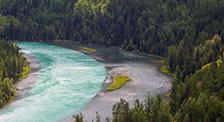Where is the Center of Asia? (according to China)
Where is the geographic center of Asia? There’s a bit of debate about the actual location. Both China and Russia claim the distinction within their borders, and both have math to prove it. I decided to see for myself where China claims to be the true “Center of Asia”. Surprisingly, it was remote and not at all what I expected.
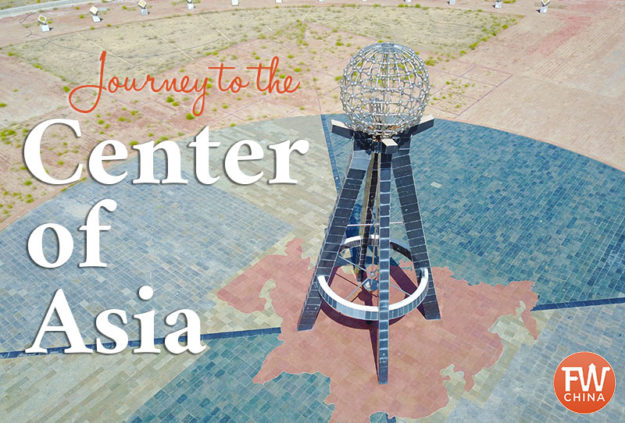
If you ask locals in China’s far western region of Xinjiang what makes the place unique, you may often hear that Xinjiang is the region furthest from the sea than anywhere in the world.
They even hold a Guinness World Record for it! (among other weird Xinjiang world records)
There’s quite a bit of politics and math that go into calculating the geographic center of Asia. However, with a simple look at a world map, it’s not hard to see that Xinjiang is pretty close to Asia’s dead center.
Chinese officials agreed and decades ago erected a monument to mark the location. I’d like to answer a few common questions about this, including:
- Where is the geographic center of Asia?
- What does it mean for China today?
- Does the monument really pinpoint the true geographic center of Asia?
Oh yea, and one more thing: is the monument even worth visiting?
Finding China’s Geographic Center of Asia
Before I dive into a written explanation of the history and travel-worthiness of China’s Center of Asia, I recommend you take a few minutes to watch this video first.
Even if you never visit yourself, it will give you a visual framework to understand the Center of Asia.
Also, keep in mind that all of this information and more is covered in the FarWestChina Xinjiang Travel Guide, the most comprehensive guide to the region with the most up-to-date information.
View more amazing Xinjiang videos on the FarWestChina YouTube channel!
History of China’s Center of Asia
Chinese sources indicate that foreign scientists were the first to determine that the geographic center of Asia was in northern Xinjiang. To confirm this claim, Chinese geographers ran a series of calculations in July of 1992. In the end, they determined the exact point of the geographic center of Asia was situated not far from the Xinjiang capital of Urumqi.
The official coordinates – as measured by the Chinese geographers in 1992 – were 43° 40′ 50″ North, 87° 19′ 52″ East. With these measurements in hand, the group of geographers marked the geographic center of Asia with a two meter tall wooden stake.
And then…they just drove off.
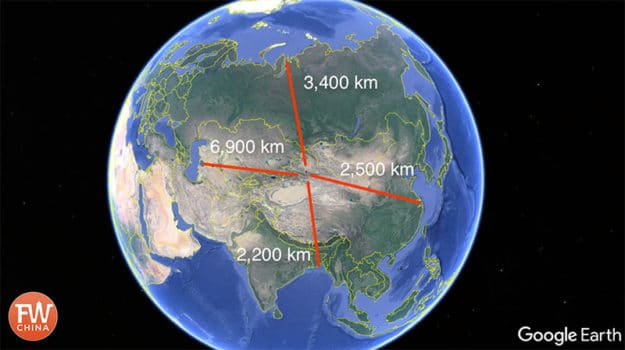
It wasn’t long before tourists began to travel out to the so-called “Heart of Asia” after the sight became popularized in local media. With rising numbers in tourists came the demand to replace the wooden stake with an actual monument pinpointing the geographic center of Asia.
The only problem? There was already a village where the wooden marker was located.
So the entire village was relocated (and lovingly renamed “Heart of Asia”) and construction began on the monument that exists today. The monument and the park where it resides was completed in the late 1990s.
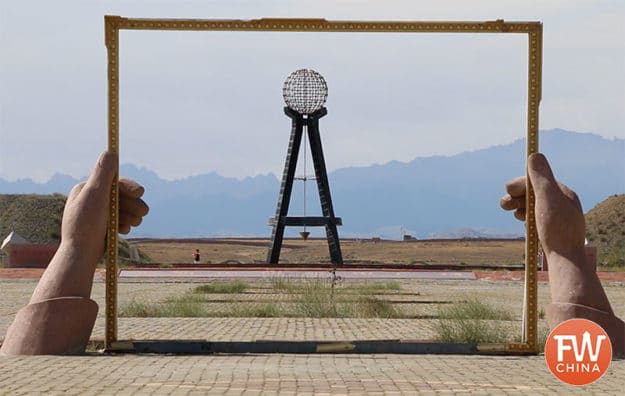
The Meaning Behind Heart of Asia
Plenty of intentional thought was put into designing the complex and monument at the geographic center of Asia.
When entering the complex, you go through a wing-shaped gate of which has a flying appearance signifying the rise of Asia’s importance in the world.
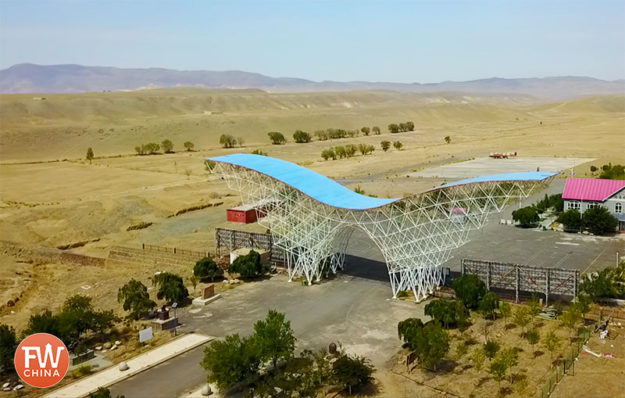
At the back of the complex is a 22 meter tall tower shaped like an “A” for Asia. On top of the tower is a steel globe with a pendulum underneath that hangs down and pinpoints the continent’s geographic center.
Surrounding the tower are cubed carvings and flags of all the Asian nations recognized by China at the time of construction depicting a sense of community across the Asian continent.
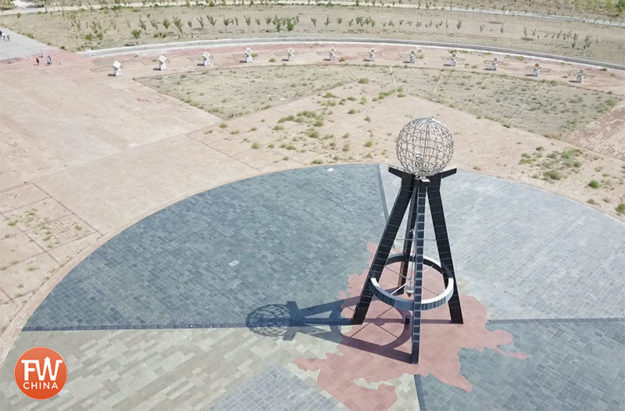
Taken all together, you get the sense that the Chinese wanted to convey through the monument that Xinjiang, while once a borderland protecting the Chinese hinterland has now emerged as the heart of Asia bridging all Asian nations together.
While you would think this would evoke much pride for locals in Xinjiang, it appears that most people here could actually care less for the monument. Time has also taken its toll on the complex as flags of some Asian nations are torn and weeds surround the tower.
Although initial news of the geographic center of Asia being discovered in Xinjiang may have caused tourists to flock there in the 1990s, today tourists are sparse, making the monument appear to be forgotten by those for which it was built.
Despite this, the idea of Xinjiang being the center of Asia and a bridge across Asian nations is more prominent now than ever before. Under One Belt, One Road (OBOR), China is seeking to revitalize the global economy through the construction of infrastructure and transportation projects thereby linking the Asian continent together along with Europe.
Xinjiang lies at the crux of this initiative and visitors to the region will doubtlessly see all the infrastructural development and propaganda showcasing Xinjiang’s central position on the New Silk Road.
Is this the True Geographic Center of Asia?
Calculating the geographic center of Asia is not an exact science and really boils down to two things: politics and methods.
The political side of the equation depends on how you answer the following question: which countries constitute “Asia”? For example do you include all the remote islands in Asia or just count the mainland? Do you include parts of eastern Europe? Is Iran part of Asia?
You can see how this can quickly become a political statement and a muddy mess.
Second, you also have to consider that there are different methods to calculate the geographic center and each gives different results. China intentionally chose a method that would yield a result not far from the capital of Urumqi.
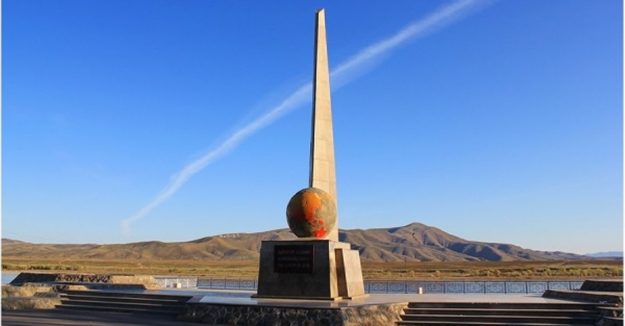
Russia, for its part, chose a different method that (surprise!) happened to yield a result within their own borders. See their monument in the photo above.
Interestingly, this monument was built decades before China ever did and it still stands a good 700km north of China’s center measurement.
Is China’s Center of Asia Worth Visiting?
If you are interested in sights like the Four Corners Monument in the US and like to take pictures standing over imaginary lines between two countries, perhaps this monument is worth seeing.
Being able to say that you have been to the geographic center of Asia also comes with its perks when sharing travel stories with friends. You may even find the area an enjoyable place to stroll through and snap photos.
However, keep in mind that this is not a bustling center of tourism. In fact, it feels like this place has fallen into disrepair and nobody seems to care. It’s a monument, sure, but there is no museum, no signs…nothing. Don’t come with high expectations!
Traveling to Geographic Center of Asia in Xinjiang
The geographic center of Asia is about an hour away from Urumqi by car and the easiest way to get there is to hire a taxi. You can also consult with local travel agencies in Urumqi and see if any tours stop there on the way to NanShan or Urumqi’s Number 1 Glacier.
If you are into cycling around Xinjiang, biking to the geographic center of Asia makes for a decent day trip to get out of Urumqi and enjoy the surrounding countryside.
Simply cycle south on Highway G216 and then turn right at 101 Provincial Road. The monument is not far from the highway and you can also stop for some delicious kabobs and yellow noodles at the small restaurants not far from the highway turnoff.
Unfortunately, there are no direct routes with public transportation.
Other useful information to plan your trip:
- Entrance Fee: 30 RMB
- Chinese Name: 亚洲大陆地理中心 (Yàzhōu dàlùdì lĭzhōngxīn)
- How much time should I spend there: 30 minutes
For all of this information and even more, make sure to grab a copy of the FarWestChina Xinjiang travel guide. It covers everything mentioned here and so much more, including helpful maps.
Final Thoughts | Center of Asia
Since its construction in the late 1990s, the geographic center of Asia has become a deteriorating symbol of importance.
Although in disrepair and sparse with visitors, a visit to the geographic center of Asia provides perspective into the initial vision that is currently unfolding where Xinjiang is the strategic core along the New Silk Road. At the very least you can enjoy the monument and leave saying you have journeyed to the center of Asia.
Have you visited the geographic center of Asia in Xinjiang? What did you think? Is there anything left out above that you think should have been covered? Let us know in the comments below!






